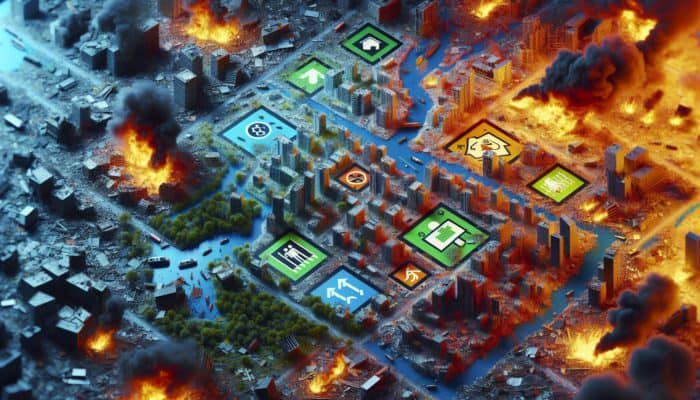Essential Steps to Take Immediately Following a Meteor Strike
Act Quickly to Find Safe Shelter

Surviving a Meteor Strike: After experiencing a meteor strike, finding a secure location for shelter is of utmost importance. The initial moments can be incredibly perilous due to shockwaves and falling debris. Optimal shelter options include basements, underground bunkers, or any robust structure that can endure the impact forces. If you find yourself outdoors, seek out ditches or ravines that can offer protection against both flying debris and shockwaves. Your primary objective is to establish a barrier between yourself and the surrounding chaos, ensuring your safety amidst the turmoil.
As you search for shelter, assess the materials available in your vicinity. Structures made of concrete provide superior protection compared to wooden ones, as they are more effective in shielding against airborne debris. Position yourself low to the ground, using your arms or any accessible items, such as jackets or bags, to shield your head and neck. This additional layer of protection can dramatically improve your chances of survival during the frantic moments following a meteor impact.
Evaluate Your Environment for Hazards
Once you have secured yourself in a shelter, it is crucial to evaluate your surroundings thoroughly. Conducting a swift assessment will help you identify immediate dangers such as fires, structural damage, or the presence of toxic gases. Look for any visible indicators of fire—such as smoke, flames, or heated surfaces. If you detect hissing sounds or observe unusual vapours, be aware that gas leaks may pose a life-threatening risk.
Additionally, check for the structural integrity of your shelter. If you are located within a building, examine walls and ceilings for cracks or significant damage that may indicate a risk of collapse. If you feel insecure, it may be wise to relocate to a more stable area. This assessment is vital and will guide your subsequent actions, ensuring not only your survival but also that of those around you.
Reach Out to Emergency Services for Help
Following a meteor strike, effective communication is indispensable. Use any available communication devices to reach out to emergency services for assistance. Whether using mobile phones, two-way radios, or basic landlines, it is essential to convey crucial information and seek support. However, be prepared for the possibility that communication networks may be down or overwhelmed; if you cannot reach someone right away, remain calm, as help is likely en route.
When you manage to connect with emergency services, provide clear information regarding your location as well as any injuries or hazards that may be present. Additionally, look for community alert systems that may offer updates or instructions regarding evacuation procedures or safety protocols. Staying informed during such chaotic times significantly enhances your chances of receiving timely help and maintaining your safety.
Provide Immediate First Aid to the Injured
If you or others around you have sustained injuries, administering first aid promptly is vital. Begin by checking for any signs of severe injuries, such as excessive bleeding, fractures, or loss of consciousness. Remember the basic principles of first aid: apply pressure to control bleeding, immobilise broken limbs, and ensure that the injured parties remain still unless necessary.
For minor injuries, cleanse wounds with clean water and apply a sterile bandage. If someone is exhibiting signs of shock, it is important to keep them calm and warm. As you administer first aid, continuously monitor their condition and look out for any worsening symptoms, as emergencies can escalate rapidly in high-stress situations. Your ability to stabilise injuries until professional medical assistance arrives could make a life-saving difference.
Secure Access to Food and Clean Water
In the aftermath of a meteor strike, access to uncontaminated food and water is crucial for survival. Traditional supply lines may be disrupted, so it is essential to ensure you have access to emergency supplies. Ensure that any water you consume is safe; if you cannot verify its safety, consider using purification methods such as boiling or filtering. Non-perishable food items, including canned goods, dried fruits, and energy bars, are ideal for maintaining energy levels during this crisis.
Be mindful of rationing your supplies carefully, especially if resources are scarce. Sharing food and water with others can strengthen community ties, but it is essential to ensure you have enough to sustain yourself first. The goal is to establish a sustainable source of nourishment and hydration until normal supply lines can be restored. Effective planning and management of food and water resources can significantly influence your survival chances after a meteor strike.
Expert Guidance on Surviving the Effects of a Meteor Strike
Comprehending Different Impact Zones for Better Safety

Understanding the characteristics of various impact zones is essential for predicting the extent of damage and shaping your survival strategy accordingly. Impact zones are categorised based on their proximity to the strike, with primary, secondary, and tertiary zones indicating different levels of destruction. The primary zone experiences the most severe damage, often resulting in the total devastation of structures.
The secondary zone may be exposed to intense heat and shockwaves, potentially leading to fires or falling debris. Even buildings located several miles away from the impact can incur damage due to the blast effects. Familiarising yourself with these zones can help you avoid high-risk areas, particularly in the immediate aftermath of the strike. Understanding local geography and infrastructure will enable you to identify safer evacuation routes and places less likely to be affected.
How to Prepare for Potential Aftershocks
Aftershocks following a meteor strike can inflict additional damage, making it imperative to prepare for them. These aftershocks can occur minutes, hours, or even days after the initial impact, posing a risk to those seeking safety in shelters that may have already sustained damage. To mitigate this risk, reinforce your shelter as best as you can. Secure doors and windows, and avoid positioning yourself near areas that are likely to collapse.
Having a well-thought-out evacuation plan in place is equally essential. Identify multiple escape routes from your location, prioritising those that minimise exposure to potential hazards. Ensure you have essential supplies packed in a go-bag for quick access. Regular drills and preparedness training can instill confidence in your community’s ability to respond effectively to aftershocks.
Strategies for Long-Term Survival Post-Impact
Long-term survival after a meteor strike hinges on securing food, water, and shelter. Establishing sustainable sources for these essentials is crucial for your well-being. Foraging may be an option, but it is crucial to understand the local ecosystem and identify edible plants. Familiarise yourself with various water purification methods, including filtration and chemical treatments, to extend your water supply.
Building communication channels with others fosters mutual support and understanding. Forming community networks can lead to the sharing of resources and the implementation of collaborative safety measures. Additionally, staying informed about recovery efforts and available resources will aid long-term survival. The importance of community ties cannot be overstated; they offer emotional support and practical assistance throughout the challenging recovery journey.
How Can You Protect Yourself During the Impact?
Utilise Available Cover for Protection
If you find yourself exposed during a meteor strike, using any available cover is critical. Vehicles and sturdy structures can shield you from flying debris and shockwaves. If no buildings are nearby, look for natural formations such as hills or large boulders. Here are some common objects that can serve as effective cover during an impact:
- Concrete walls or barriers
- Vehicles (cars, trucks, buses)
- Heavy machinery or equipment
- Large trees or rock formations
- Underground structures or basements
- Artificial structures like bridges
When seeking cover, always remember to protect your head and neck with your arms or any available materials. The objective is to minimise your exposure to potential hazards. By taking swift action and wisely utilising your surroundings, you can significantly reduce your risk of injury during a meteor impact.
Avoid Proximity to Windows for Safety
During a meteor strike, windows pose a considerable threat as they can shatter and inflict serious injuries. Staying away from them is crucial for your safety. Glass shards can fly at high speeds, leading to severe cuts and injuries. If you are indoors, seek an interior room or hallway where the walls provide additional protection.
If you are outside, it is equally important to maintain distance from structures with large windows. The risk of glass shattering increases significantly in areas where the impact generates strong winds or pressure waves. Protecting yourself from these dangers involves understanding your environment and making informed decisions based on the immediate conditions.
Drop, Cover, and Hold On for Safety
Similar to earthquake safety protocols, the mantra of drop, cover, and hold on can also be applied during a meteor strike. If you perceive the ground shaking, drop to the ground immediately to prevent being knocked over. Next, cover your head and neck with your arms and seek sturdy furniture, such as a table or desk, if accessible.
Hold on to your shelter until the shaking ceases. This technique helps protect vital areas of your body and provides a stable base during the tumultuous moments that follow the impact. The key is to remain as calm as possible, as panic can lead to poor decision-making during such critical situations.
Wear Protective Gear to Enhance Safety
Wearing protective gear during a meteor strike is essential. Items such as helmets, goggles, and protective clothing can shield you from debris and potential impact injuries. If you have access to safety gear, ensure that you utilise it effectively. Helmets are particularly crucial as they provide vital protection for your head from falling objects.
Additionally, sturdy clothing can offer a buffer against cuts and abrasions. If you reside in an area prone to meteor strikes, having a well-prepared emergency kit that includes protective gear can be a lifesaver. Consider keeping this gear readily accessible, as being prepared allows for swift action in the event of unpredictable events.
Stay Alert and Follow Emergency Alerts
Staying informed and adhering to instructions from emergency services is vital during a meteor impact event. Authorities will provide critical guidance on necessary actions, which could include evacuation orders or instructions to shelter in place. Tuning into local radio stations or using emergency apps can help you receive timely updates regarding the situation.
Being proactive and attentive to emergency alerts can mean the difference between safety and peril. Emergency services are trained to assess situations and provide critical information in real time, so it is essential to heed their instructions closely. Understanding the situation can empower you to make informed decisions and effectively protect yourself and those around you.
What Are the Signs of an Impending Meteor Strike?
Recognise Unusual Light in the Sky
A bright flash or unusual light in the sky may serve as an early indicator of a meteor entering the atmosphere. This phenomenon is often fleeting but can precede the impact by mere moments. Stay alert for changes in light that appear out of place, as this can signal imminent danger. Other atmospheric phenomena that might suggest an impending meteor strike include:
- Bright streaks across the sky
- Shifting colours to unusual hues
- Sudden darkness during the daytime
- Intense blue or green flashes
Being aware of these signals can help you react swiftly and seek safety. If you observe any unusual light patterns, do not hesitate; take cover immediately, as the time between observation and impact can be incredibly brief.
Listen for Sonic Booms
The sound of a meteor entering the atmosphere often manifests as a sonic boom, indicating its proximity. This sonic boom occurs when the meteor travels faster than the speed of sound, producing a loud, explosive sound as it breaks through the atmosphere.
Listening for such sounds can serve as an auditory warning, prompting you to prepare for the impending impact. If you hear a sonic boom, evacuate to a safe location if possible. Your ability to recognise these auditory cues can significantly enhance your preparedness and response to the looming threat of a meteor strike.
Be Aware of Unusual Seismic Activity
Meteors can trigger seismic waves upon impact, which may manifest as unusual seismic activity. If you notice trembling or vibrations in the ground, it could indicate an impending strike. Please pay attention to local seismic reports, as they may provide insights into unusual patterns occurring in your area.
Being vigilant about these signs can help you react promptly. If you sense seismic activity, take immediate action to secure yourself and seek shelter. Awareness of these indicators will enhance your ability to respond effectively to a potentially catastrophic event.
Essential Supplies for Survival After Impact
Ensure Adequate Water and Food Supplies
Stockpiling sufficient water and non-perishable food is critical for survival, especially in the aftermath of a meteor strike. Aim to gather supplies that can last at least two weeks to account for potential disruptions in access to resources. Store water in clean, sealed containers to ensure that it remains uncontaminated.
Non-perishable food options include canned goods, dried fruits, nuts, and energy bars. These items are not only easy to store but also provide essential nutrients to sustain energy levels during the crisis. Regularly rotate your supplies to prevent spoilage, ensuring they remain fresh and ready for use when needed.
Maintain a Comprehensive First Aid Kit
A well-stocked first aid kit is essential for treating injuries and preventing infection in the aftermath of a meteor strike. Ensure your kit includes items such as antiseptics, bandages, gauze, scissors, and pain relievers. Please familiarise yourself with the contents of the kit to ensure you can use it efficiently in emergencies.
Consider adding specific items based on the needs of your region, such as allergy medications or specialised medical supplies for chronic conditions. Regularly inspect and replenish your first aid kit to ensure it remains equipped for any eventuality. A reliable first aid kit can make a significant difference in managing injuries until professional medical assistance becomes available.
Reliable Communication Devices Are Vital
Having reliable communication devices is vital for staying informed and connected with emergency services and loved ones. Mobile phones, two-way radios, and even whistle systems can facilitate communication in the aftermath of a meteor strike when traditional communication lines may be down.
Consider keeping backup power sources, such as portable chargers or solar-powered devices, within your emergency preparedness kit. Understanding how to use these devices effectively can be crucial in securing assistance and information during times of crisis. By maintaining open lines of communication, you can better navigate the challenges of survival and recovery.
Research-Backed Benefits of Surviving a Meteor Strike
Fostering Enhanced Community Resilience
Surviving a meteor strike can significantly enhance community resilience. The shared experience of navigating a catastrophic event fosters a stronger sense of community and cooperation. This collective strength can lead to improved preparedness for future disasters, as individuals come together to share knowledge and resources.
Communities that prioritise post-disaster recovery often witness a surge in volunteerism and local engagement. By collaborating, residents can pool resources and knowledge, leading to more effective response strategies. The relationships formed during recovery efforts can create enduring bonds that further enhance community resilience against future threats.
Improvements in Emergency Response Systems
Analysing the response to a meteor strike can yield insights that facilitate improvements in emergency response systems. Lessons learned from past events can inform better training, technology adoption, and protocols for future emergencies. This continuous improvement cycle ensures that emergency services can respond more effectively to catastrophic incidents.
Incorporating feedback from survivors into training programmes can enhance preparedness and strengthen response strategies. Communities can collaborate with local authorities to establish improved communication networks and evacuation plans, ensuring that everyone is better equipped to handle such unpredictable events in the future.
Valuable Lessons for Future Preparedness
Survivors of a meteor strike often provide valuable insights into what was effective and what fell short during the crisis. These lessons for future preparedness are crucial for enhancing community resilience. By sharing experiences and strategies, communities can refine their disaster preparedness plans, ensuring that they are better equipped for future scenarios.
Public forums, workshops, and educational initiatives can help disseminate this knowledge. Engaging in community drills and simulations can also prepare individuals for real-life situations. The proactive sharing of experiences fosters a culture of preparedness that can ultimately save lives in the future.
How Can You Assist Others Following a Meteor Strike?
Provide First Aid Assistance as Needed
If you possess first aid training, offering assistance can be invaluable in the aftermath of a meteor strike. Treating injuries and stabilising those in need until professional help arrives can significantly improve their chances of recovery. Begin by assessing the most critical cases, prioritising individuals with severe or life-threatening injuries.
While administering first aid, maintain a calm demeanour to instill confidence in those around you. Use the supplies in your first aid kit effectively, and remember to protect yourself while treating others. Your skills can make a life-saving difference during the chaotic aftermath of an impact.
Share Resources to Support Your Community
During times of crisis, it is vital to share resources with those in greater need. Distributing your supplies, such as water, food, and medical kits, fosters a sense of community support. Each person’s survival can be closely linked to the well-being of others, making collective resource-sharing essential.
By being generous with your supplies, you not only assist others but also strengthen community bonds. Encourage those around you to do the same, creating a culture of support and cooperation. The interconnectedness of individuals can significantly enhance survival prospects in the aftermath of a meteor strike.
Organise Community Rescue Efforts
Taking a leadership role in organising search and rescue efforts can expedite the process of locating and assisting those who may be trapped or injured. Collaborating with local authorities and emergency responders can enhance the effectiveness of these efforts. Mobilising community members to search designated areas ensures that no one is left behind.
Establishing clear communication channels is crucial for coordinating rescue efforts. Use available devices to relay information about individuals needing help and to share updates on ongoing searches. By rallying community support, you can create a more efficient response to the aftermath of a meteor strike.
Offer Emotional Support During Recovery
Providing comfort and counselling can help individuals cope with trauma and loss after a meteor strike. Emotional recovery is just as important as physical recovery, as people may grapple with fear, anxiety, and grief stemming from the incident. Listening and offering a supportive presence can make a significant difference for those struggling to process the event.
Encourage community gatherings or support groups where survivors can share their experiences and feelings with others who have had similar experiences. Creating safe spaces for dialogue facilitates emotional healing and recovery. Your willingness to be present for others can foster resilience within the community and promote collective healing.
Strategies for Long-Term Recovery and Rebuilding
Repairing Infrastructure Post-Impact
Rebuilding damaged infrastructure is essential for restoring normalcy and ensuring the community’s long-term survival. The physical landscape must be evaluated for structural integrity, and repairs should be prioritised based on urgency. Engaging local contractors and volunteers can expedite recovery efforts.
The rebuilding process extends beyond mere physical structures; it also involves restoring the community spirit. Involving residents in the rebuilding process can rekindle a sense of ownership and pride, fostering a collaborative mindset crucial for long-term resilience. As infrastructure is restored, communities can emerge from the impact with renewed strength.
Providing Mental Health Support to Survivors
Offering mental health support to survivors is vital for helping them cope with the trauma and stress of the event. Trauma can manifest in various ways, from anxiety to depression, and addressing these issues is essential for community recovery. Collaborate with mental health professionals to provide counselling services and support groups.
Raising awareness about mental health resources within the community encourages those in need to seek help. Providing educational materials on coping strategies empowers survivors to manage their emotions more effectively. Prioritising mental health ensures that individuals can heal and positively contribute to rebuilding efforts.
Reorganising Community Structures for Resilience
After a meteor strike, communities may need to reorganise their social and economic structures to adapt to the new post-impact reality. This process might involve reevaluating local leadership, resource distribution, and community roles to align with the new needs of the population.
Encouraging community discussions allows residents to voice their ideas and contribute to planning efforts. Active participation fosters a sense of belonging and ensures that diverse perspectives are considered in the reorganisation process. By embracing adaptability and a collaborative spirit, communities can rebuild stronger than ever.
Frequently Asked Questions
What immediate actions should I take after a meteor strike?
After a meteor strike, seek shelter immediately to protect yourself from debris and shockwaves, then assess your surroundings for hazards. Contact emergency services and administer first aid if necessary.
How can I prepare for aftershocks that may follow a meteor strike?
Secure your shelter to withstand potential aftershocks, and prepare an evacuation plan. Stay informed and ready to move if structural integrity is compromised.
What essential supplies should I have for post-impact survival?
Stockpile sufficient water and non-perishable food to last at least two weeks, along with a well-stocked first aid kit and reliable communication devices.
What signs might indicate that a meteor strike is imminent?
Unusual lights in the sky, sonic booms, and unusual seismic activity may signal an impending meteor strike. Stay vigilant and ready to act quickly.
How can I assist others after a meteor strike?
Provide first aid, share resources, organise rescue efforts, and offer emotional support to help those in need. Community cooperation is essential for recovery.
What should I do if I’m outdoors when a meteor strikes?
Look for available cover, such as vehicles or sturdy structures, and protect yourself from flying debris. Stay low and shield your head and neck.
How does surviving a meteor strike enhance community resilience?
Surviving such catastrophic events fosters cooperation and strengthens community ties, leading to improved preparedness for future disasters and stronger community bonds.
What improvements can be made to emergency response systems after a meteor strike?
Analysing the response to past events can inform better training, technology, and protocols, ensuring that emergency services can respond effectively in future scenarios.
How can communities reorganise after a meteor strike?
Communities may need to reevaluate local leadership and roles, encouraging active participation in planning and resource distribution to adapt to the new reality.
What role does mental health support play in the recovery process?
Mental health support is critical for helping survivors cope with trauma and stress, facilitating emotional healing, and ensuring individuals can contribute positively to rebuilding efforts.
Explore our journey on X!
Post-Disaster Bartering: Essential Strategies
Exploring the Concept of Post-Disaster Bartering What Is the Concept of Post-Disaster Bartering? Post-Disaster Bartering: Post-disaster bartering refers to the exchange of goods and services that occurs when conventional currency systems collapse due to catastrophic events, such as natural disasters, economic crises, or societal upheavals. During these critical moments, individuals and communities utilise the resources […]
Hurricane Generator Use: Powering Through Storms
Maximising the Benefits of Hurricane Generator Usage What Exactly Are Hurricane Generators? Hurricane Generator Use: Hurricane generators are advanced power supply devices specifically engineered to deliver electricity during extreme weather events, particularly during hurricanes, when standard power infrastructures may fail. These robust machines ensure that both residential and commercial establishments receive the power they need, […]
Emergency Family Plan: Universal Preparation Guide
Comprehensive Elements to Include in Your Family Emergency Plan Effective Communication Strategies for Emergencies Emergency Family Plan: Establishing effective communication strategies is absolutely vital for ensuring that family members remain connected and informed during emergencies. It’s crucial to have clear, reliable methods in place that everyone understands and can utilise effortlessly. This encompasses traditional communication […]
Survival Water Bottles: Essential Gear for Emergencies
Why Survival Water Bottles are Essential for Emergency Preparedness Understanding the Significance of Hydration in Crisis Situations Survival Water Bottles: Maintaining hydration is vital for ensuring optimal bodily functions during emergencies. In scenarios where access to clean water is limited, sustaining proper hydration is crucial in preventing health complications associated with dehydration, which can include […]








I’ve never really thought about the aftermath of a meteor strike until now, and it’s pretty wild how much chaos can follow such an incredible event. Your point about finding secure shelter right away hits home—it’s something we often take for granted in our day-to-day lives. In a way, it reminds me of emergency preparedness that we often see pushed for natural disasters like hurricanes or earthquakes.